
Grasses Around Las Vegas, Vegetation Around Las Vegas
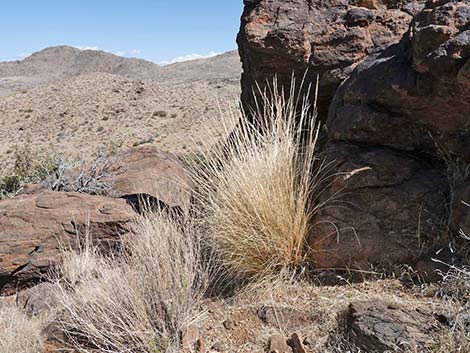 |
General: Bunchgrass is the general name for perennial grass species that tend to grow in discrete tufts or clumps (i.e., bunches) rather than in sod-like carpets. Bunchgrasses tend to have deep roots and can get moisture from the soil when shallow-rooted sod-like grasses would dry out. There are several species of bunchgrass around Las Vegas, a few of which are easy to recognize, but to the casual observer, it is sufficient to recognize bunchgrasses as different from "carpet" grasses and from Sedges (e.g., Scirpus spp.) and Rushes (e.g., Juncus spp.): Sedges [sedge stems] have edges, Rushes [rush stems] are round, And Grasses have leaves all the way to the ground. Experts use various characteristics of the flowers and seeds to identify individual species. |
 |
Native Bunchgrasses are a good indicator of the health of desert vegetation communities. Most of the desert has been grazed by cattle, horses, burros, or sheep during historic times, and herds of these animals tend to overgraze bunchgrasses to near extirpation. Thus, if bunchgrasses are present, the vegetation community probably has never been overgrazed and probably is healthy. Bunchgrasses are common components of vegetation associations in the Upper Sonoran (Mojave Desert Scrub and Pinyon-Juniper Woodland), Transition (Yellow Pine Forest), and Canadian (Pine-Fir Forest) life zones except in areas overgrazed by cattle. Bunchgrasses can also be found at higher and lower elevations, but in smaller numbers. Family: Grass (Poaceae). Other Names: Each species has at least one name. |
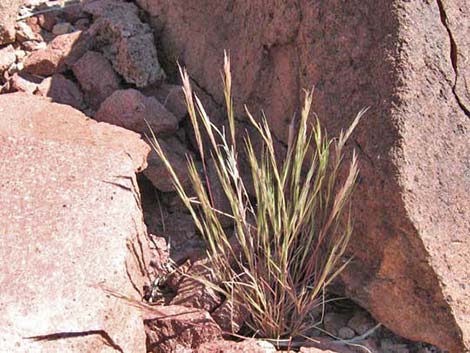 |
Plant Form: Grass; growing upright in bunches. Height: Leaves usually to about shin-high; seed stalks to about thigh-high. Stem: Usually round, hollow. Leaves: Long and narrow, like grasses. Flowers: Inflorescence is a panicle; branchlets upright on stalk to drooping in bunches. Flowers tiny. Seeds: Achene-like grain (like small sunflower seeds). Habitat: Most desert habitats from the low desert to the high mountains. |
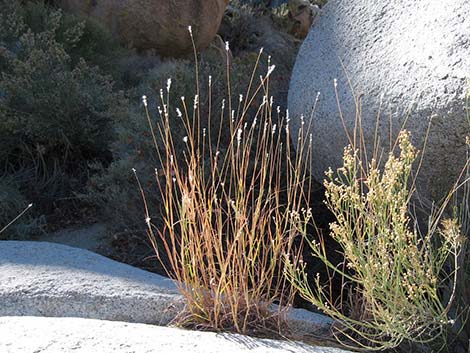 |
Elevation: To 10,000+ ft Distribution: Worldwide. Comments: There are many species of grass, spread across many genera, that exhibit the bunchgrass life form. Some common species of bunchgrass that are fairly easy to identify are listed below. |
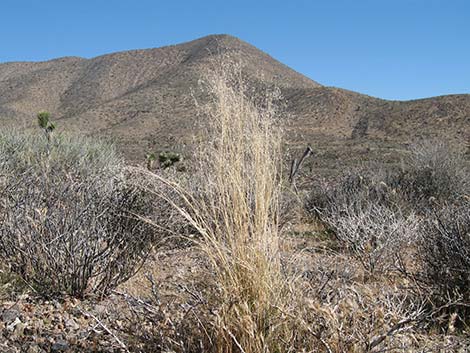 |
Sand Ricegrass (Achnatherum hymenoides) is a stately bunchgrass that grows to about 2 feet and has a wide, open mass of branched flower stalks. The many seeds are relatively large and rice-like. Native peoples and pioneers harvested the seeds. Ricegrass tends to grow in sandy soils at elevations below about 6,500 ft. |
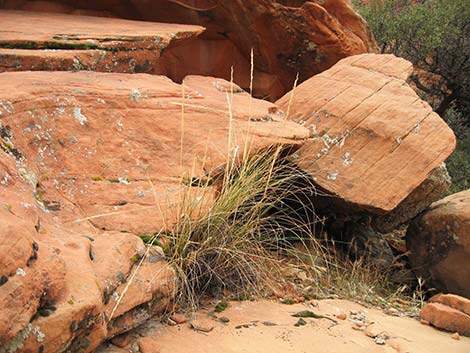 |
Desert Needlegrass (Achnatherum speciosum [Stipa speciosa]). Desert Needlegrass is a large bunchgrass that grows to about 2-feet tall and 2-feet wide. There are many seed stalks per plant, each with a 4-inch-long, tight panicle of flowers. The long awns attached to the seeds are twisted and sharply bent at the middle. Desert Needlegrass tends to grow in rocky soils and washes at elevations below about 7,000 feet. |
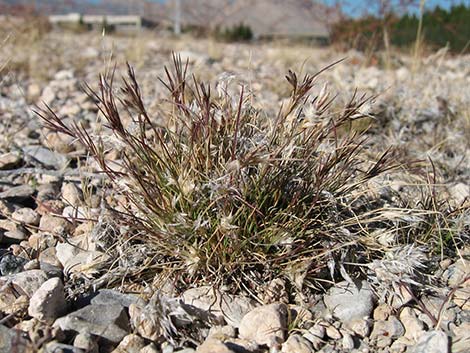 |
Fluffgrass (Dasyochloa pulchella). Fluffgrass is a small bunchgrass that only grows 4-6 inches tall. The leaves are short, and the seed stalks barely stand above the leaves. The flower spikelets are covered in silvery hairs, giving the plant a fluffy white appearance. Fluffgrass grows in sandy and rocky soils at elevations of about 1,000 to 5,500 feet. |
![Big Galleta Grass (Pleuraphis rigida [Hilaria rigida])](../Pleura_rig/p-pr/IMG_03326a.jpg) |
Big Galleta Grass (Pleuraphis rigida [Hilaria rigida]). Big Galleta Grass is a big bunchgrass that grows to about 3.5-feet tall. Leaves are long and narrow. Stems grow erect with long (to 6 inches), open seedheads. The 0.5-inch-long spikelets radiate from the end of the spike. Big Galleta Grass grows on sandy and rocky soils at elevations below about 5,000 feet. |
Note: All distances, elevations, and other facts are approximate. Names generally follow the USDA database.
![]() ; Last updated 230609
; Last updated 230609
| All Grasses | Plant Species Index | Glossary | Copyright, Conditions, Disclaimer | Home |